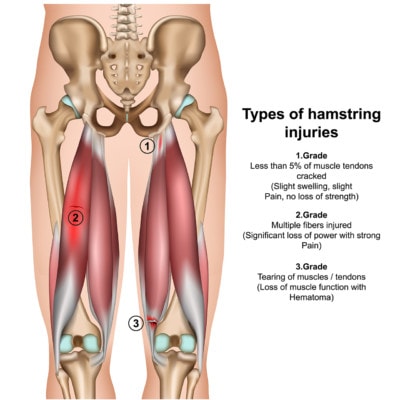Making a Hamstring Surgery Decision? Meet Abby…
Abby is a middle aged woman who is very active in high level yoga and was recently faced with a difficult hamstring surgery decision. She came to see me last year with a hamstrings tear where one surgeon had told her to operate and a second had said to try PRP. She’s now about 95% better after a series of precise image guided injections without surgery!

Medicalstocks/Shutterstock
The hamstrings area where Abby had pain was where the muscle originates deep in the buttocks. Everyone has heard of the “hammys”, which is actually a collection of muscles in the back of the thigh that not only help bend the knee, but are also critical for normal knee functions like moving the meniscus out of the way with knee flexion. The hamstrings muscles can be torn with trauma or just wear and tear, which causes pain and spasm in the lower buttocks and/or back of the thigh.
Abby is big into yoga and began noticing in 2014 that any sudden movement caused severe pain in the buttocks and back of the thigh. After an MRI showed a partial tear, one surgeon told her that she would need surgery, but thankfully a second opinion was less certain that surgery would help, but thought PRP might do the trick. PRP is platelet rich plasma, or a concentrated cocktail of blood platelets injected to prompt healing.
When Abby was evaluated, like many patients with hamstrings issues, she also had clear evidence of an S1 nerve issue in her back, so treating her successfully would have to also involve placing the growth factors isolated from her blood platelets around her irritated back nerves through an epidural injection. Why? While we have been taught that the nerve and the muscle are different and distinct structures, in reality, what happens to one (the nerve) causes issues in the other (muscle). When I first injected her hamstring tendon, I was alarmed by how the MRI had clearly underestimated the tendon tear, as I could see the tendon flying apart on the ultrasound image with every injection. This meant that parts of the tendon were literally like tissue paper. After I injected the tendon several times using the Regenexx-SCP procedure, the tendon became firmer and more solid, showing good signs of healing. Now Abby reports 95% improvement, with just a twinge in this area every once in awhile.
The upshot? Hamstring tears used to be surgical issues when they didn’t respond to physical therapy. However, the downtime from those procedures is massive, which didn’t fit with Abby’s love for difficult yoga postures. In the end, thankfully, just a few precise injections of her own concentrated blood platelets were needed to help her avoid the knife!

NOTE: This blog post provides general information to help the reader better understand regenerative medicine, musculoskeletal health, and related subjects. All content provided in this blog, website, or any linked materials, including text, graphics, images, patient profiles, outcomes, and information, are not intended and should not be considered or used as a substitute for medical advice, diagnosis, or treatment. Please always consult with a professional and certified healthcare provider to discuss if a treatment is right for you.
